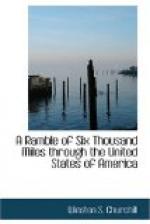In a museum at New York, I saw one of those mummies alluded to, which appeared to be remarkably small; but I had not an opportunity of examining it minutely. Those that have been found in the most perfect state of preservation were deposited in nitrous caves, and were enveloped in a manner so different from the practices of the Indians, that the idea cannot be entertained of their being the remains of the ancestors of the present race. Flint gives the following description of one of them which he carefully examined. He says, “The more the subject of the past races of men and animals in this region is investigated, the more perplexed it seems to become. The huge bones of the animals indicate them to be vastly larger than any that now exist on the earth. All that I have seen and heard of the remains of the men, would seem to shew that they were smaller than the men of our times. All the bodies that have been found in that high state of preservation, in which they were discovered in nitrous caves, were considerably smaller than the present ordinary stature of men. The two bodies that were found in the vast limestone cavern in Tennessee, one of which I saw at Lexington, were neither of them more than four feet in height. It seems to me that this must have been nearly the height of the living person. The teeth and nails did not seem to indicate the shrinking of the flesh from them in the desiccating process by which they were preserved. The teeth were separated by considerable intervals; and were small, long, white, and sharp, reviving the horrible images of nursery tales of ogres’ teeth. The hair seemed to have been sandy, or inclining to yellow. It is well known that nothing is so uniform in the present Indian as his lank black hair. From the pains taken to preserve the bodies, and the great labour of making the funeral robes in which they were folded, they must have been of the ‘blood-royal,’ or personages of great consideration in their day. The person that I saw, had evidently died by a blow on the skull. The blood had coagulated there into a mass, of a texture and colour sufficiently marked to shew that it had been blood. The envelope of the body was double. Two splendid blankets, completely woven with the most beautiful feathers of the wild turkey, arranged in regular stripes and compartments, encircled it. The cloth on which these feathers were woven, was a kind of linen of neat texture, of the same kind with that which is now woven from the fibres of the nettle. The body was evidently that of a female of middle age, and I should suppose that her majesty weighed, when I saw her, six or eight pounds.”




